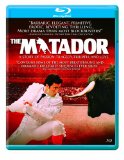| Reviews & Columns |
|
Reviews DVD TV on DVD Blu-ray 4K UHD International DVDs In Theaters Reviews by Studio Video Games Features Collector Series DVDs Easter Egg Database Interviews DVD Talk Radio Feature Articles Columns Anime Talk DVD Savant Horror DVDs The M.O.D. Squad Art House HD Talk Silent DVD
|
DVD Talk Forum |
|
|
| Resources |
|
DVD Price Search Customer Service #'s RCE Info Links |
|
Columns
|
|
|
Matador (2008), The
City Lights // Unrated // March 17, 2009
List Price: $29.98 [Buy now and save at Amazon]
The Film:
Photos by Mauricio Berho, Courtesy of City Lights
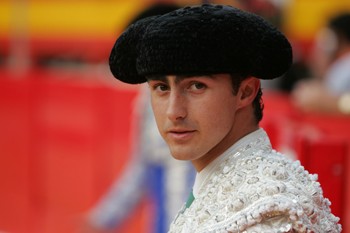 Watching a documentary on a subject with two points of view can be difficult, but it's even more so when you empathize with the merits behind each side of the argument. The Matador is a marked example, blending brutality with artistry into a documentary about an age-old spectacle. The best part is that it goes out of the way to acknowledge the line drawn in the sand -- and doesn't try to sway people's opinions, but more make them appreciate the magnificence lying atop the grotesquery.
Watching a documentary on a subject with two points of view can be difficult, but it's even more so when you empathize with the merits behind each side of the argument. The Matador is a marked example, blending brutality with artistry into a documentary about an age-old spectacle. The best part is that it goes out of the way to acknowledge the line drawn in the sand -- and doesn't try to sway people's opinions, but more make them appreciate the magnificence lying atop the grotesquery.
It's the story of David Fandila, a fresh star in the bullfighting arena who goes by the name "El Fandi". His story reminds me of the effects that Deion Sanders and Dennis Rodman had on their respective sports with their deviation from the norm, adding youthful flash to a somewhat dated framework. Now, that doesn't mean that David trollops into the ring sporting heavy, gold-plated jewelry around his neck and neon paint coating his hair. However, his jerky, less-fluid style has taken on a following despite its deviation from classic techniques. Most intriguing is his age, capturing him at a youthful twenty-one (21). But he's not cocky, nor flagrant; instead, David showcases a profound respect for the sport, both in the ring and out. The tone around him reminds me a little bit of the bullfighting elements in Pedro Almodovar's Talk to Her, making it clear that David is a full-blown celebrity in his circles with physical and timely demands that makes it almost impossible to sneak in moments of normal human interaction.
His presence comes a close second in the line-up of driving forces that you soak in with The Matador, with the actual fights themselves as the primary. His disposition -- eerily similar to that of a Spanish Edward Norton, which adds to the charismatic appeal in his narrative -- fuels our curiosity in discovering how he became a budding star in this "archaic" sport. It glides through three years of his professional career, introducing us to the idea of David achieving the pinnacle of performing in one-hundred (100) bullfights in the span of a year. As we're taken through his journey, as well as being introduced to his family and business colleagues, we get a sense of both David Fandila as a human being as well as the way that "El Fandi" integrates into the current state of bullfighting. Following him as he approaches his goals in the sport -- and reach an incredible climax where he defies the traditional structure of the corrida (surname for the bullfight) by fighting six bulls in one day -- becomes an enthralling portrait.
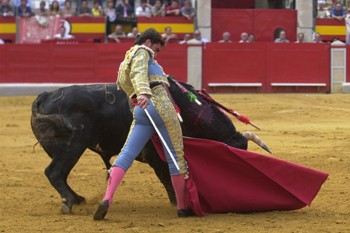 Through sly editing and a careful eye, The Matador takes us through every aspect of the ritual/sport/spectacle, what have you -- from behind-the-scenes training to several expanses of footage from the fights themselves -- and transforms it into a surprising affective experience. The corrida footage, captured at both ground level and in the arena seats for a spectator's eye view, is truly breathtaking. It lets us get ravishingly close to the action, allowing the audience to view each breath the bull takes to each slight movement that the matador makes himself. With natural editing, it offers an experience that comes close to watching the real thing unfold in front of you. Whether that's something you really want to see in all its gory, painstaking detail is another story. Make no mistake, it's brutal, bloody, and altogether disheartening, but the majesty present in each matador's projection as a hero of sorts is entrancing.
Through sly editing and a careful eye, The Matador takes us through every aspect of the ritual/sport/spectacle, what have you -- from behind-the-scenes training to several expanses of footage from the fights themselves -- and transforms it into a surprising affective experience. The corrida footage, captured at both ground level and in the arena seats for a spectator's eye view, is truly breathtaking. It lets us get ravishingly close to the action, allowing the audience to view each breath the bull takes to each slight movement that the matador makes himself. With natural editing, it offers an experience that comes close to watching the real thing unfold in front of you. Whether that's something you really want to see in all its gory, painstaking detail is another story. Make no mistake, it's brutal, bloody, and altogether disheartening, but the majesty present in each matador's projection as a hero of sorts is entrancing.
There's no sugar coating going on in The Matador, but they do offer up a chance to educate us on their point of view by answering a few questions -- like what happens to the bulls after the final blow is dealt and how the matadors, as a collective, feel about their craft. There's a surprising lack of forced justification, instead taking a road less traveled by modestly acknowledging that it's an enduring art form with a grizzly resolution. Now, David defends the ritualistic killing of a cow raised for beef as a way of giving it a fighting chance, which might have carried more gravity if the odds weren't stocked so high in the matadors' favor (walls to hide behind, assistance to fluster the victim, etc). At least he's got his heart in it.
Probably the most intriguing and provocative thing about The Matador comes in the way that it presents the enemies to the "torture" sport, the negative energy that aims to force it into the history books as a dated and barbaric ritual. Some documentaries try to dodge the opposition and aim straight for the purity within its nature, but not this one. The Matador, fully aware of its brutal nature, instead aims to elucidate the entire process -- from training and development to the actual corrida itself -- with the perception that bullfighting is a cultural relic in a holding pattern. Several journalists lend interview time to the film, many of which have differing opinions on the longevity to the art of the "corrida", all of which acknowledge that it's stuck in a place as being an enduring cultural element vital to Spain's essence.
Though a dated and oft-ridiculed artform, it's still thriving. Something about the "there's no such thing as bad advertising" likely applies here, as one person's protest is another person's vice. You'll probably come out of The Matador unchanged in the ways you feel either for or against the sport, but it'll certainly enhance whichever direction you were leaning. For those on the fence between appreciation and denouncement of its somewhat cruel essence, it'll really tantalize the sensations felt for both spectrums. Bold and certain to instill a few gasps, it's a documentary that's well worth seeing regardless of personal position. The key thing to take away about The Matador is that it reveals most of the things that stay "out of sight, out of mind" regarding the surface image of bullfighting, which builds it into an experience you'll likely not forget -- or want to revisit frequently.
The Blu-ray:
Video and Audio:
Presented from City Lights in a nicely done VC-1 encode, The Matador showcases a swift level of detail and clarity. Switching aspect ratios whenever the source material shifts -- from 1.78:1 with the film's core footage to 1.33:1 as the archival footage crops up -- it wavers in quality throughout. The core material of the documentary, framed for widescreen displays, looks rather good for its slightly soft source material. It showcases fine detail across the board, from textures in clothing to some faraway details in the crowd.
However, it does have some problems rendering facial detail and tones at several points, as well as an extraordinarily tough time projecting solid coloring in sky-focused shots. Also, there's a fair amount of grain in the image, especially in the few darker scenes in the film. The bold level of sharpness and color saturation, however, easily counterbalance these problems in other scenes. When the material leaks over into low-grade, full-frame material, it has some bigger issues -- heavy aliasing and murky details primarily. Given the fluctuating qualities of the source, City Lights does an admirable job with this high-definition transfer.
Audiowise, we're working with a Dolby Digital 5.1 track that sounds pretty strong for being a legacy track. Activity persistently comes out from all directions, even if the rears are mostly used for crowd chatter and musical accompaniment. Vocal clarity is very sound, never pinching the upper levels of the audio track to distortion-worthy points or dipping to inaudibility when it can. Plus, the daring musical accompaniment sounds rather wonderful throughout, adding plenty of personality to the proceedings. Subtitles, which are handled extremely well, are only available in non-optional English to match the sole Dolby 5.1 track.
Special Features:
Introduction to Bullfighting (8:45, SD MPEG-2):
Edward Levine takes us through the steps of a traditional bullfight, from the parade and arena aesthetics to the structure of the fight itself. It blends footage from several of the fights available on the disc with his commentary, which stays to the point and educational. He makes points of mentioning bullfighting's standing as a sport, as well as the lack of advertising present in the arena.
Also available are over forty-five minutes of raw Bullfight Footage from Spain (46:56) -- two corridas, to be exact -- as well as a high-definition Trailer, a nice Photo Gallery, and a Music Video.
Final Thoughts:
The Matador becomes entrancing on a visceral level quite early, then leads us through "El Fandi" path from stardom to super-stardom with resonance. I'm surprised at how stunning the bullfight sequences looked, both with the way they were composed and how close the photographer could get to their battles. Though brutal and not exactly the kind of content you're likely to want to watch many times over, it's still a satisfying and unabashed depiction of one of Spain's seminal culture elements. City Lights' Blu-ray looks and sounds fine, with a serviceable line-up of special features, which makes this questionably rewatchable documentary a strong Rental.
Thomas Spurlin, Staff Reviewer -- DVDTalk Reviews | Personal Blog/Site
Photos by Mauricio Berho, Courtesy of City Lights
 Watching a documentary on a subject with two points of view can be difficult, but it's even more so when you empathize with the merits behind each side of the argument. The Matador is a marked example, blending brutality with artistry into a documentary about an age-old spectacle. The best part is that it goes out of the way to acknowledge the line drawn in the sand -- and doesn't try to sway people's opinions, but more make them appreciate the magnificence lying atop the grotesquery.
Watching a documentary on a subject with two points of view can be difficult, but it's even more so when you empathize with the merits behind each side of the argument. The Matador is a marked example, blending brutality with artistry into a documentary about an age-old spectacle. The best part is that it goes out of the way to acknowledge the line drawn in the sand -- and doesn't try to sway people's opinions, but more make them appreciate the magnificence lying atop the grotesquery. It's the story of David Fandila, a fresh star in the bullfighting arena who goes by the name "El Fandi". His story reminds me of the effects that Deion Sanders and Dennis Rodman had on their respective sports with their deviation from the norm, adding youthful flash to a somewhat dated framework. Now, that doesn't mean that David trollops into the ring sporting heavy, gold-plated jewelry around his neck and neon paint coating his hair. However, his jerky, less-fluid style has taken on a following despite its deviation from classic techniques. Most intriguing is his age, capturing him at a youthful twenty-one (21). But he's not cocky, nor flagrant; instead, David showcases a profound respect for the sport, both in the ring and out. The tone around him reminds me a little bit of the bullfighting elements in Pedro Almodovar's Talk to Her, making it clear that David is a full-blown celebrity in his circles with physical and timely demands that makes it almost impossible to sneak in moments of normal human interaction.
His presence comes a close second in the line-up of driving forces that you soak in with The Matador, with the actual fights themselves as the primary. His disposition -- eerily similar to that of a Spanish Edward Norton, which adds to the charismatic appeal in his narrative -- fuels our curiosity in discovering how he became a budding star in this "archaic" sport. It glides through three years of his professional career, introducing us to the idea of David achieving the pinnacle of performing in one-hundred (100) bullfights in the span of a year. As we're taken through his journey, as well as being introduced to his family and business colleagues, we get a sense of both David Fandila as a human being as well as the way that "El Fandi" integrates into the current state of bullfighting. Following him as he approaches his goals in the sport -- and reach an incredible climax where he defies the traditional structure of the corrida (surname for the bullfight) by fighting six bulls in one day -- becomes an enthralling portrait.
 Through sly editing and a careful eye, The Matador takes us through every aspect of the ritual/sport/spectacle, what have you -- from behind-the-scenes training to several expanses of footage from the fights themselves -- and transforms it into a surprising affective experience. The corrida footage, captured at both ground level and in the arena seats for a spectator's eye view, is truly breathtaking. It lets us get ravishingly close to the action, allowing the audience to view each breath the bull takes to each slight movement that the matador makes himself. With natural editing, it offers an experience that comes close to watching the real thing unfold in front of you. Whether that's something you really want to see in all its gory, painstaking detail is another story. Make no mistake, it's brutal, bloody, and altogether disheartening, but the majesty present in each matador's projection as a hero of sorts is entrancing.
Through sly editing and a careful eye, The Matador takes us through every aspect of the ritual/sport/spectacle, what have you -- from behind-the-scenes training to several expanses of footage from the fights themselves -- and transforms it into a surprising affective experience. The corrida footage, captured at both ground level and in the arena seats for a spectator's eye view, is truly breathtaking. It lets us get ravishingly close to the action, allowing the audience to view each breath the bull takes to each slight movement that the matador makes himself. With natural editing, it offers an experience that comes close to watching the real thing unfold in front of you. Whether that's something you really want to see in all its gory, painstaking detail is another story. Make no mistake, it's brutal, bloody, and altogether disheartening, but the majesty present in each matador's projection as a hero of sorts is entrancing. There's no sugar coating going on in The Matador, but they do offer up a chance to educate us on their point of view by answering a few questions -- like what happens to the bulls after the final blow is dealt and how the matadors, as a collective, feel about their craft. There's a surprising lack of forced justification, instead taking a road less traveled by modestly acknowledging that it's an enduring art form with a grizzly resolution. Now, David defends the ritualistic killing of a cow raised for beef as a way of giving it a fighting chance, which might have carried more gravity if the odds weren't stocked so high in the matadors' favor (walls to hide behind, assistance to fluster the victim, etc). At least he's got his heart in it.
Probably the most intriguing and provocative thing about The Matador comes in the way that it presents the enemies to the "torture" sport, the negative energy that aims to force it into the history books as a dated and barbaric ritual. Some documentaries try to dodge the opposition and aim straight for the purity within its nature, but not this one. The Matador, fully aware of its brutal nature, instead aims to elucidate the entire process -- from training and development to the actual corrida itself -- with the perception that bullfighting is a cultural relic in a holding pattern. Several journalists lend interview time to the film, many of which have differing opinions on the longevity to the art of the "corrida", all of which acknowledge that it's stuck in a place as being an enduring cultural element vital to Spain's essence.
Though a dated and oft-ridiculed artform, it's still thriving. Something about the "there's no such thing as bad advertising" likely applies here, as one person's protest is another person's vice. You'll probably come out of The Matador unchanged in the ways you feel either for or against the sport, but it'll certainly enhance whichever direction you were leaning. For those on the fence between appreciation and denouncement of its somewhat cruel essence, it'll really tantalize the sensations felt for both spectrums. Bold and certain to instill a few gasps, it's a documentary that's well worth seeing regardless of personal position. The key thing to take away about The Matador is that it reveals most of the things that stay "out of sight, out of mind" regarding the surface image of bullfighting, which builds it into an experience you'll likely not forget -- or want to revisit frequently.
The Blu-ray:
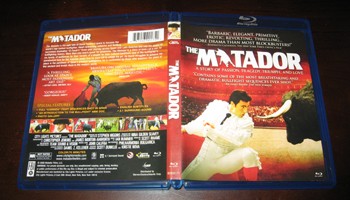 | 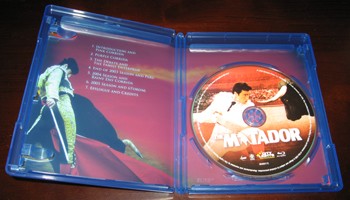 |
Video and Audio:
Presented from City Lights in a nicely done VC-1 encode, The Matador showcases a swift level of detail and clarity. Switching aspect ratios whenever the source material shifts -- from 1.78:1 with the film's core footage to 1.33:1 as the archival footage crops up -- it wavers in quality throughout. The core material of the documentary, framed for widescreen displays, looks rather good for its slightly soft source material. It showcases fine detail across the board, from textures in clothing to some faraway details in the crowd.
However, it does have some problems rendering facial detail and tones at several points, as well as an extraordinarily tough time projecting solid coloring in sky-focused shots. Also, there's a fair amount of grain in the image, especially in the few darker scenes in the film. The bold level of sharpness and color saturation, however, easily counterbalance these problems in other scenes. When the material leaks over into low-grade, full-frame material, it has some bigger issues -- heavy aliasing and murky details primarily. Given the fluctuating qualities of the source, City Lights does an admirable job with this high-definition transfer.
Audiowise, we're working with a Dolby Digital 5.1 track that sounds pretty strong for being a legacy track. Activity persistently comes out from all directions, even if the rears are mostly used for crowd chatter and musical accompaniment. Vocal clarity is very sound, never pinching the upper levels of the audio track to distortion-worthy points or dipping to inaudibility when it can. Plus, the daring musical accompaniment sounds rather wonderful throughout, adding plenty of personality to the proceedings. Subtitles, which are handled extremely well, are only available in non-optional English to match the sole Dolby 5.1 track.
Special Features:
Introduction to Bullfighting (8:45, SD MPEG-2):
Edward Levine takes us through the steps of a traditional bullfight, from the parade and arena aesthetics to the structure of the fight itself. It blends footage from several of the fights available on the disc with his commentary, which stays to the point and educational. He makes points of mentioning bullfighting's standing as a sport, as well as the lack of advertising present in the arena.
Also available are over forty-five minutes of raw Bullfight Footage from Spain (46:56) -- two corridas, to be exact -- as well as a high-definition Trailer, a nice Photo Gallery, and a Music Video.
Final Thoughts:
The Matador becomes entrancing on a visceral level quite early, then leads us through "El Fandi" path from stardom to super-stardom with resonance. I'm surprised at how stunning the bullfight sequences looked, both with the way they were composed and how close the photographer could get to their battles. Though brutal and not exactly the kind of content you're likely to want to watch many times over, it's still a satisfying and unabashed depiction of one of Spain's seminal culture elements. City Lights' Blu-ray looks and sounds fine, with a serviceable line-up of special features, which makes this questionably rewatchable documentary a strong Rental.
|
| Popular Reviews |
| Sponsored Links |
|
|
| Sponsored Links |
|
|
| Release List | Reviews | Shop | Newsletter | Forum | DVD Giveaways | Blu-Ray | Advertise |
|
Copyright 2024 DVDTalk.com All Rights Reserved. Legal Info, Privacy Policy, Terms of Use,
Manage Preferences,
Your Privacy Choices | |||||||









